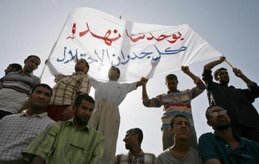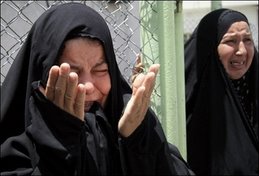water worries: three million drink from mosul’s poisoned river
One of the problems that the oft-troubled northern city of Mosul does not have is a water supply. The Tigris River passes through the city, the capital of the state of Ninawa, dividing it into two coasts. And as it passes through, the river’s waters are used by a wide variety of businesses and private households on its banks.
The local sewage department estimates that there are 172 sources of sewage pouring about half a million cubic meters of waste water into the river daily, including waste water from private households and factories, some of which are state-owned.
On the banks of the Tigris, there are a number of construction sites, industrial areas and one large medical complex. Various types of liquids and solids find their way into the river, some of them dangerous, many of them untreated and polluting. In the past, reports have suggested that medical waste was being thrown directly into the river – even though the local health department denies this.
“One of the biggest cities in Iraq after Baghdad, and Mosul doesn’t even have a real sewage system,” the head of the local sewage department, engineer Anwar Ammar, complained. “The current system was designed to collect rainwater but now it’s used to dispose of industrial, commercial and residential wastewater. There is only one real sewage system in two small residential compounds,” he added.
Some of the first to draw attention to the problems the local populace is facing as the Tigris gets more polluted, were local fishermen. There’s been a decrease in numbers making a living this way and the federal Ministry of Agriculture published a report indicating that fish stock numbers were falling right around Iraq, and that the main cause was water pollution.
“The quality of the river waters has been worsening for some time – because there’s less water in the river, the changes in river temperature and the increased amount of floating oil slicks and other waste,” local fisherman Abu Ali, 50, said. “Fish are not coming into the river anymore. Ten years ago fish from the Tigris, especially the carp, were sold all over Iraq,” he noted.
Aware of the seriousness of this issue, the local government formed a committee in August 2011 to assess the levels of pollution in the Tigris River. The committee confirmed that around 100,000 tons of salt and chemicals were finding their way into the river every year. Crude oil, and crude oil derivatives, from the Kasak area in western Mosul, were also finding their way into the river.
Dried animal dung was entering the river around the Badush area, through which the Tigris flowed, and there was also an impact from heavy metals coming from a former military installation upriver. Cadmium, which can cause a variety of health problems, was a particular issue.
Reports from the province’s water department, sighted by NIQASH, mention other reasons for concern. Untreated wastes from cities north of Mosul – Zakho and Dohuk – end up in the Khabur River, which then flows into the Tigris.
Unfortunately the main water purification plant serving Mosul’s population for drinking water is located on the Tigris River. “The river is at risk and those concerned with water purification must rely mainly on chlorine for purification processes,” Mohammed al-Ghannam, the chairman of Mosul's environment and health committee, explained. As al-Ghannam, who is an ophthalmologist by profession, pointed out: “this has an impact on people’s health”.
Additionally, he said, diseases like cholera were spreading and kidney disease and allergies were on the rise too. “If river pollution is not controlled there will be serious consequences,” he said.
Local power stations were also having an impact. “Thermal power stations cause pollution too because they use water for cooling their motors, and this too affects the water ecology,” Fakhri Yassin, a professor of engineering at Mosul University, explained. “The sand and gravel quarries on the upper side of the river have also contributed to pollution because they’ve increased the amount of plankton in the river. This in turn leads to an enormous consumption of oxygen in the water. And that is why medium sized and larger fish have become rare in the river.”
The local committee tasked with researching the issue concluded by saying that waste shouldn’t be dumped into the Tigris, if it hadn’t been treated according to generally accepted international standards. The committee also suggested that special regulations be introduced to ban the dumping of untreated solids and liquids. It also suggested more sophisticated water purification methods, banning quarrying activities around the river and, most importantly, initiating the construction of a real sewage network for Mosul.
Unfortunately over two months have passed since the committee made these suggestions and up until now, no further action has been taken.
And despite all of the evidence that the Tigris River and its tributaries were becoming more and more polluted, local government departments still seem to prefer to play things down.
According to official statements from local departments of water and the environment, more than 3 million people rely on the river for drinking water. The undeclared intention of that statement, according to critics: they’re drinking it and they’re not dead yet.
This story was prepared as part of the Media academy Iraq’s mentorship programme for young Iraqi journalists, together with NIQASH’s regular correspondents around Iraq. The mentor for this story was regular NIQASH contributor Saleh Elias.
http://www.niqash.org/articles/?id=2998&lang=ar
نقاش | عبد الهادي محمد | الموصل | 22.02.2012
امتياز الموصل كونها أكثر المدن العراقية حظا في المياه العذبة، بات عرضة للخطر، فدلالات البيانات الرسمية والدراسات العلمية المتخصصة تضع علامات استفهام كثيرة حول نسبة التلوث الحقيقية في النهر.
يمر نهر دجلة في المدينة من جهتها الشمالية الغربية ليقسمها إلى ساحلين، حيث تستقبله بكثافة البيوتات والمؤسسات والشركات والمصانع والمستشفيات الحكومية والخاصة متراصة على الجانبين الأيمن والأيسر.
دائرة مجاري نينوى أعلنت عن وجود 172 مصبا تلقي في النهر يوميا حوالي نصف مليون متر مكعب من المياه الآسنة، مصدرها ليس الاستعمال المنزلي فقط، وانما المصانع التابعة للدولة والخاصة التي تلفظ فضلاتها الى مجرى النهر من تحت قبضة الرقابة الرخوة او اللارقابة.
يضاف الى ذلك اربع مناطق صناعية للسيارات والمكائن المتنوعة ومعدات البناء بجميعها، والمجمع الطبي الكبير (خمس مستشفيات كبيرة وعدد من المراكز الطبية) على ضفة النهر، وقد كشفت تقارير اعلامية سابقة عن القاء مخلفات طبية في النهر مباشرة، وهو ما نفته دائرة الصحة.
الفضلات السائلة والصلبة بمصادرها المتعددة ومستوياتها المتفاوتة في الخطورة، تجد طريقها أخيرا الى النهر بلا معالجة.
فقد أوضح معاون مدير المجاري المهندس عمار أنور لموقع "نقاش" أن ثاني اكبر مدينة عراقية بعد بغداد "تفتقر تماما إلى مجار للصرف الصحي، إلا في مجمعين سكنيين صغيرين"، متابعا "ان الشبكة الحالية ظاهرية وهي مصممة اساسا لتجميع مياه الامطار لكنها تستخدم الان في المناطق السكنية والصناعية والتجارية لتصريف المياه المستعملة".
ويضيف انور ان منطقة بادوش (8 كم شمال غرب الموصل) التي يمر فيها نهر دجلة قبل الموصل تلقي ما يقارب الـ(10) طن من الروث الجاف لحيوانات الجاموس يوميا. مما يشكل مشكلة كبيرة عند العمل على تنقية مياه الشرب.
كما ان مياه العيون الكبريتية التي تتدفق من سد بادوش بمعدل 300 متر مكعب في الساعة اضافة الى بقايا تأثيرات العناصر الثقيلة وتحديدا الكادميوم الناتج من نشاط سابق لاحدى المنشات العسكرية، تشكل مصادر تلوث ملفتة للانتباه.
والكادميوم وفقا لمختصين هو عنصر فلزي لين قد يسبب الفشل الكلوي أو ارتفاع ضغط الدم.
التراجع الذي أصاب مهنة صيد السمك في الموصل بعد ان كانت من أكثر المدن ازدهارا في الصيد، كان احدى الدلالات التي جعلت المعنيين بتربية الأسماك في العراق السباقين الى التنبيه لمخاطر تلوث مياه دجلة.
وكان صدر مؤخرا عن وزارة الزراعة كتاب رسمي يعزو تراجع أعداد الأسماك في عموم العراق لأسباب كثيرة من أبرزها التلوث. وهذا ما أكده المهندس لؤي شاكر مسؤول الثروة السمكية في مديرية الزراعة.
وتضيف تقارير مديرية ماء محافظة نينوى، التي اطلع عليها مراسل "نقاش" مصادر قلق أخرى حول تلوث النهر، تتمثل فيما تطرحه كل من مدينتي دهوك وزاخو (شمال الموصل) من فضلات مياه غير معالجة في رافد الخابور ومنه إلى دجلة.
ويبدو هذا القلق مشروعا لان محطة تصفية المياه الرئيسة لمدينة الموصل التي توفر مياه الشرب لأغلب سكانها تقع في بحيرة سد الموصل التي تتشكل من مياه النهر بما فيها ما يصل من الخابور.
رئيس لجنة الصحة والبيئة في مجلس المحافظة محمد الغنام اكد "ان النهر في مرحلة خطرة في ظل ضعف امكانات الدوائر المعنية بتنقية المياه التي تعتمد فقط على استخدام الكلور".
ويضيف الغنام وهو طبيب "ان آثار ذلك على الصحة واضحة، فهناك انتشار متزايد لأمراض الكوليرا والكلى والحساسية وغيرها"، مطالبا الدوائر المعنية بالعمل على تدارك هذا الخطر بجدية كبيرة.
بعد ان تحسست الحكومة المحلية الخطر، قامت في آب (أغسطس) الماضي بتشكيل لجنة لدراسة حجم التلوث في نهر دجلة. وجاء في تقريرها أن مئة الف طن من الاملاح والمواد الكيمياوية تجد طريقها الى النهر سنويا عبر مبازل مشروع ري الجزيرة العملاق غرب المحافظة جراء الري الجائر. كذلك تتكرر حالات تسرب النفط الخام ومشتقاته خاصة في منطقة الكسك غرب المدينة.
بدوره يقول أبو علي، وهو صياد سمك تجاوز عمره الـ (50 عاما) "ان حالة النهر باتت سيئة جدا، حيث انخفضت كميات المياه كثيرا واضحت اكثر برودة، كما اشاهد باستمرار بقعا زيتية ونفايات صلبة طافية فيه" .
وأضاف "النهر هنا بات يطرد السمك فمن النادر جدا إن نصطاد فيه سمكا كان قبل عشرة سنوات يملئ الأسواق ويباع في المحافظة وخارجها، وبخاصة الشبوط".
كما أن انخفاض كميات المياه المطلقة عبر بحيرة السد (50 كم غربا) الى النهر بنحو 80% في الثانية، "أثر سلبا على أداء محطات الاسالة من الناحية التشغيلية وتردي نوعية المياه بشكل كبير جدا"، حسبما ورد في محضر اللجنة الحكومية الذي حصل موقع "نقاش" على نسخة منه.
ومن حسن الحظ أن محطات تنقية المياه أقيمت في اعالي مجرى النهر، باستثناء محطة الدندان جنوبي المدينة وهي "موقع خاطئ" وفقا لمختصين.
"المحطات الحرارية لتوليد الكهرباء هي الاخرى تترك ملوثات فيزيائية ناتجة عن استخدام الماء لتبريد المحركات الضخمة مؤثرا بذلك على حالة الماء الايكولوجية"، حسب قول فخري ياسين استاذ الهندسة الصحية والبيئة في جامعة الموصل .
ويضيف "إن مقالع الحصى والرمل (مواد انشائية) المنتشرة في اعالي النهر، ساهمت بدورها في زيادة نسبة العوالق الكامنة في قعر النهر وبالتالي استهلاك جزء كبير من الاوكسجين، مفسرا بذلك ندرة الاسماك المتوسطة والكبيرة في النهر المار في المدينة لإضافة للكثير من الكائنات المائية الاخرى".
كل هذه المؤشرات لم تثنِ مديريتي البيئة والماء عن التقليل من خطر التلوث في مياه النهر، "والا لما استطاع ما يزيد على الثلاثة ملايين شخص الاعتماد عليها في الشرب والاستعمالات الاخرى"، وفق تصريحات رسمية من مسؤولي المديريتين.
مع ذلك فان لجنة الدراسة وللحد من نسبة التلوث أوصت ببعض النقاط من ابرزها منع رمي المخلفات السائلة والصلبة في مجرى النهر الا بعد معالجتها وفق المحددات العالمية واصدار تشريع بذلك، ومنع نشاط المقالع واستدراج مربي الجاموس الى مواقع جنوب المدينة، واعتماد اساليب اكثر تطورا في تنقية مياه الاسالة وربما الاهم من كل ذلك تنفيذ مشروع لانشاء شبكة مجاري الصرف الصحي.
لكن المؤسف انه إلى تاريخ اعداد هذا التحقيق لم تتحرك الحكومة المحلية باتجاه تنفيذ التوصيات التي تمخضت عن اللجنة المختصة رغم مرور 70 يوما على إعلانها، بحسب عضوها المهندس عمار انور معاون مدير المجاري.
تم انجاز هذه القصة من خلال برنامج Mentorship وهو مشروع تدريبي للصحفيين الشباب في "أكاديمية الإعلام- العراق"، بالتعاون مع مراسلي موقع "نقاش" في مختلف محافظات العراق.









